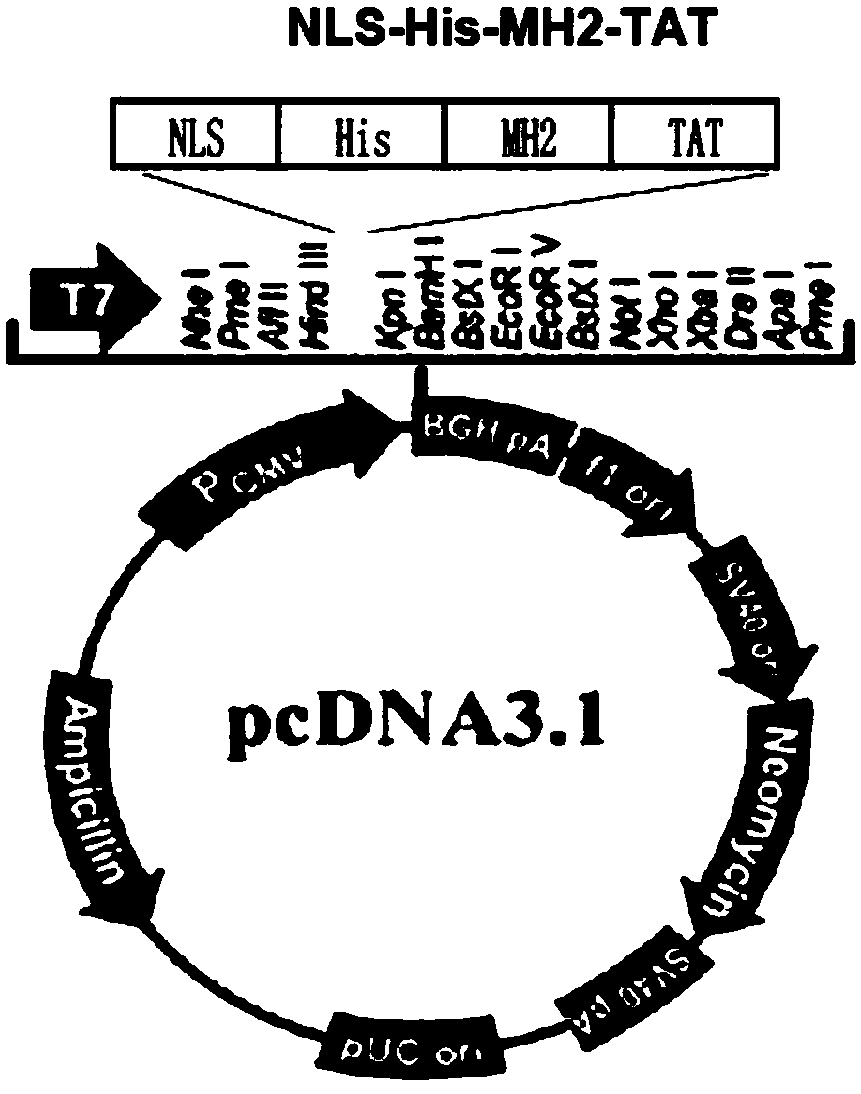Eukaryotic recombinant protein specifically inhibiting stat3 activity and its preparation method and application
A recombinant protein and specific technology, applied in the field of medical bioengineering, can solve the problems that the effect and safety are difficult to meet expectations, and achieve the effect of inhibiting proliferation and promoting sensitivity
- Summary
- Abstract
- Description
- Claims
- Application Information
AI Technical Summary
Problems solved by technology
Method used
Image
Examples
Embodiment 1
[0051] The eukaryotic recombinant protein that specifically inhibits STAT3 activity provided by Example 1 of the present invention, through genetic manipulation, the 166 amino acid sequence of the amino terminal (C terminal) of the transcription factor Smad6 that can bind to PIAS3 is named MH2, in MH2 The nuclear localization peptide NLS is connected at the N-terminus, the transmembrane signal peptide TAT is connected at the C-terminus of MH2, and the His tag is added between NLS and MH2. The functional region code of the eukaryotic recombinant protein that specifically inhibits STAT3 activity is: NLS-His- MH2-TAT; the eukaryotic recombinant protein that specifically inhibits STAT3 activity has a total length of 210 amino acids, of which 1-25 are NLS sequences, 26-31 are His sequences, 34-199 are MH2 sequences, 200-210 are TAT sequences, Two amino acids of KL are used to connect the His tag sequence and the MH2 sequence; the amino acid sequence of the eukaryotic recombinant pro...
Embodiment 2
[0073] Add 500 μM eukaryotic recombinant protein NLS-His-MH2-TAT that specifically inhibits STAT3 activity to the cultured 293T cells, fix with 4% paraformaldehyde after 6 hours for subsequent immunofluorescence staining;
[0074] Double immunofluorescent staining using anti-His mouse monoclonal antibody and anti-tubulin rabbit polyclonal antibody, see Figure 4 , Figure 4 It is a schematic diagram of the cellular localization of the eukaryotic recombinant protein that specifically inhibits STAT3 activity using immunofluorescence double staining provided in Example 2 of the present invention. The results show that the eukaryotic recombinant protein NLS-His-MH2-TAT that specifically inhibits STAT3 activity not only Can enter the cell, and smoothly located in the nucleus.
Embodiment 3
[0076] The cultured 293T cells were co-transfected with HA-PIAS3, Flag-Smad6-NLS and Myc-Ub, and the cells were co-treated with different concentrations of eukaryotic recombinant protein NLS-His-MH2-TAT that specifically inhibited STAT3 activity. After 24 hours, Treat with 10 μM MG132 for another 4 hours, and detect the ubiquitination and degradation changes of HA-PIAS3 after harvesting the protein; see Figure 5 , Figure 5 It is a schematic diagram of the eukaryotic recombinant protein that specifically inhibits STAT3 activity provided by Example 3 of the present invention to inhibit the ubiquitination and degradation of PIAS3 protein by Smad6, and the results show that the eukaryotic recombinant protein NLS-His-MH2-TAT that specifically inhibits STAT3 activity inhibits Protein ubiquitination and degradation of PIAS3 by Smad6.
[0077] HA-PIAS3, Flag-Smad6-NLS and SIE plasmid (STAT3 reporter gene plasmid) were co-transfected in cultured 293T cells, and the cells were co-tre...
PUM
 Login to View More
Login to View More Abstract
Description
Claims
Application Information
 Login to View More
Login to View More - R&D
- Intellectual Property
- Life Sciences
- Materials
- Tech Scout
- Unparalleled Data Quality
- Higher Quality Content
- 60% Fewer Hallucinations
Browse by: Latest US Patents, China's latest patents, Technical Efficacy Thesaurus, Application Domain, Technology Topic, Popular Technical Reports.
© 2025 PatSnap. All rights reserved.Legal|Privacy policy|Modern Slavery Act Transparency Statement|Sitemap|About US| Contact US: help@patsnap.com



